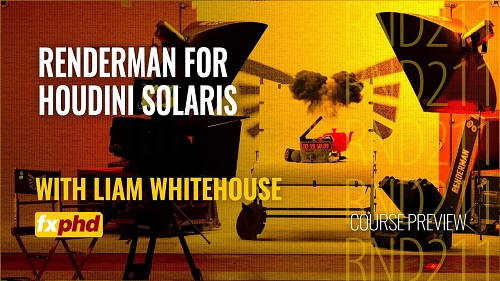
FXPHD – RND211 – RenderMan for Houdini Solaris (Unzipped)
English | Tutorial | Size: 3.1GB
Class Listing
Class 1: Getting Started in Houdini Solaris
Covering the USD translation from Houdini to Solaris, how to view the USD scene hierarchy, switch objects on or off and navigate the scene and the user interface and an overview of the geometry, materials, lighting, camera and render settings used in Solaris in the following classes.
Class 2: Geometry in Solaris
The Solaris Geometry workflow will be covered to set geometry Renderman attributes and the workflow for adding displacement to surfaces. Finally, we will cover adding subdivisions and the render geometry settings to set visibility, trace sets, matte IDs, and dicing.
Class 3: Shading in Solaris
How to create a material in Solaris and assign it to geometry, the different types of surfaces that you may need to assign materials to, how to render SOP Volumes, and how to create Material X networks.
Class 4: Shading in Solaris
How to convert textures, the extensive Preset browser in Solaris, which is a large material library you can utilise for authoring materials and surfaces, and how to create Solo Material / Patterns.
Class 5: Cameras in Solari
How to set Bokeh, Depth of Field, the Shutter, the viewing Transformation, and how to use projection plugins. One of the great strengths of Pixar Renderman 26 is its ability to reproduce the film look of a digital cinema camera with CG footage, so we will cover how to replicate these looks using PxrCamera.
Class 6: Lighting in Solaris
How to create different light types, how to adjust their parameters, the base properties, shaping and shadow tabs, the colour, intensity and exposure settings. The Renderman parameters and how to use the Light Mixer node to control all lighting in one convenient location.
Class 7: Lighting in Solaris continued
How to do light linking using a light linker node, how to use different light filters for lights and gobos to control their shape and outline, and how do you set up and use mesh lights for Renderman in Solaris?.
Class 8: Renderman settings in Solaris
Renderman settings in Solaris, including resolution, output, the integrator and filters, the Solaris Render Settings LOP under the Renderman tab, and Pixar ML Denoising to get noise-free renders for preview or final output.
Class 9: Light Path Expressions
Light Path Expressions are a powerful way to collect and output specific light paths for alteration later, how to setup and control motion blur in Solaris, checkpointing and recovery and how to setup Crytomattes in Solaris.
Class 10: Renderman Kaboom Box HDA
How to use the HDA, which will greatly speedup pyro and volumetric workflows, allowing quick and easy lookdev and rendering of fire, explosions, candles and anything in between. The HDA offers both basic and advanced pyro lookdev controls plus a few presets to get artists going quickly.
DOWNLOAD:
RAPIDGATOR:
rapidgator.net/file/0f04f8cac30582333565e51a5d3d8d08/rnd211_-_renderMan_for_houdini_solaris.part1.rar.html
rapidgator.net/file/96791a5578760d8ef438c0ca7763a940/rnd211_-_renderMan_for_houdini_solaris.part2.rar.html
rapidgator.net/file/33fc08fc36db8240db4b7a4954c3fac1/rnd211_-_renderMan_for_houdini_solaris.part3.rar.html
TURBOBIT:
trbt.cc/kkcq1opapzhn/rnd211_-_renderMan_for_houdini_solaris_-_torrent.part1.rar.html
trbt.cc/hw1ljomdl7z3/rnd211_-_renderMan_for_houdini_solaris_-_torrent.part2.rar.html
trbt.cc/4kgygzlogtav/rnd211_-_renderMan_for_houdini_solaris_-_torrent.part3.rar.html